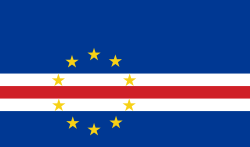
Back الراس الاخضر ARZ Capverdians Catalan Кабовердтер Kazakh Кабоверделиктер Kirghiz Kabowerdeńczycy Polish Cabo-verdianos Portuguese Кабовердцы Russian Zelenortci Serbo-Croatian 佛德角人 Chinese
 | |
| Total population | |
|---|---|
| c. 500,000–850,000 Cape Verdean ancestry and citizenship worldwide | |
| Regions with significant populations | |
| 312,084[2] [3] | |
| 33,119[4]–102,853[5] | |
| 38,000[6] | |
| 25,000 (1995) | |
| 21,218 (2011)[7] | |
| 15,000 (1995)[8] | |
| 10,000[2] [9] | |
| 10,000 (1999)[10] | |
| 9,400[11] | |
| 6,843[11] | |
| 6,000 | |
| 5,000 | |
| 4,831 (2024)[12] | |
| 4,000 (1999)[13] | |
| 3,500 (1995)[14] | |
| 2,562 (2021)[15] | |
| 1,237[11] | |
| 1,000 | |
| 1,000 | |
| Languages | |
| Cape Verdean Creole, Portuguese | |
| Religion | |
| Predominantly Roman Catholicism Protestantism, Irreligion | |
| Related ethnic groups | |
| • West Africans mainly: Wolof people, Serer people, Mandinka people, Biafada people, Papel people • Europeans mainly Portuguese people | |
Cape Verdeans, also called Cabo Verdeans (Portuguese: cabo-verdiano), are a people native to Cape Verde, an island nation in West Africa consisting of an archipelago in the central Atlantic Ocean. Cape Verde is a multi-ethnic society, which means that it is home to people of many different ethnic backgrounds. Cabo Verdeans do not consider their nationality as an ethnicity but as a citizenship with various ethnicities.
- ^ "Estado da população cabo-verdiana". Archived from the original on 2014-11-13. Retrieved 2015-01-12.
- ^ a b A Semana. "Cape Verdeans make up 15.7% of all foreigners in Portugal." Retrieved January 20, 2008. Archived February 29, 2008, at the Wayback Machine
- ^ 1995 Cape Verdean Diaspora Population Estimates Archived 2009-08-29 at the Wayback Machine
- ^ "PLACE OF BIRTH FOR THE FOREIGN-BORN POPULATION IN THE UNITED STATES, Universe: Foreign-born population excluding population born at sea, 2007-2011 American Community Survey 5-Year Estimates". United States Census Bureau. Retrieved 16 July 2013.[dead link]
- ^ "American FactFinder - Results 2011". US Census Bureau. Archived from the original on 12 February 2020. Retrieved 9 May 2016.
- ^ "Institute for Security Studies - Institut d'Études de Sécurité .:". iss.co.za. Archived from the original on 2008-02-29.
- ^ CBS 2010
- ^ University of Massachusetts - Dartmouth. "1995 Cape Verdean Diaspora Population Estimates." Retrieved on October 18, 2007. Archived August 29, 2009, at the Wayback Machine
- ^ 1995 Cape Verdean Diaspora Population Estimates Archived 2009-08-29 at the Wayback Machine
- ^ OECD 2004
- ^ a b c "Cape Verde - International emigrant stock".
- ^ Immigrants in Brazil (2024, in Portuguese)
- ^ Cape Verdean Diaspora Population Estimates, Caboverde Informatics Project, University of Massachusetts Dartmouth, archived from the original on 2009-08-29, retrieved 2009-08-26
- ^ 1995 Cape Verdean Diaspora Population EstimatesArchived 2009-08-29 at the Wayback Machine
- ^ "Une large palette de nationalités". statistiques.public.lu (in French). Retrieved 2024-02-03.
© MMXXIII Rich X Search. We shall prevail. All rights reserved. Rich X Search